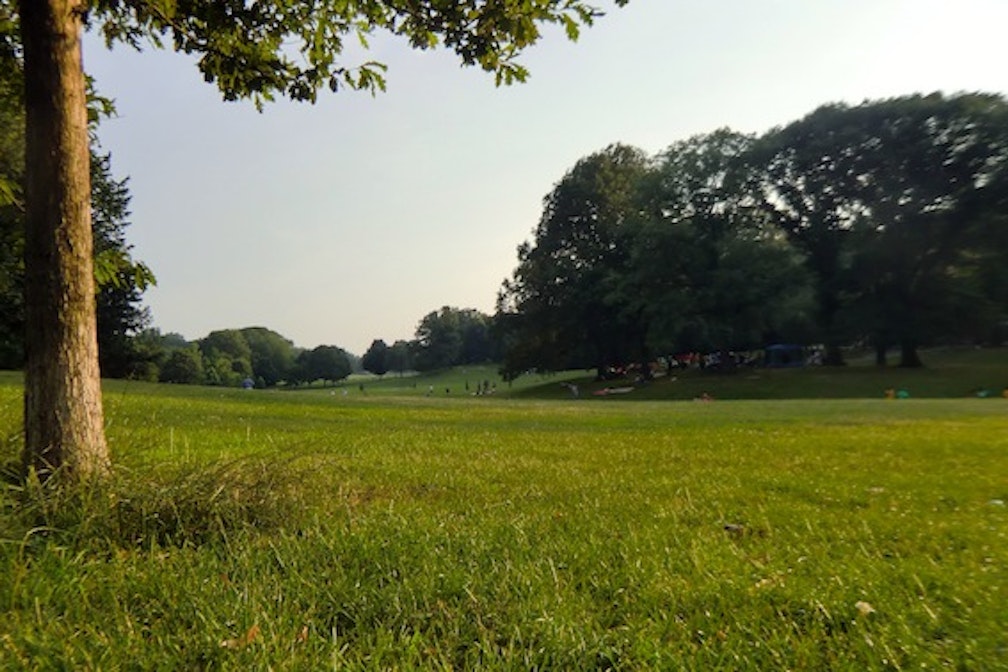
What Central Park is to Manhattan, Prospect Park is to Brooklyn: wide spaces, rolling meadows, and the occasional squirrel. Much like its better known cousin between 59th and 110th Streets, Brooklyn’s roughly 2.4km² large green lung is not just meeting point, running track, and one large BBQ grill on Sundays, but also artistic playground where urban and bucolic fantasies produce a particular mix of naturalistic hermitages, architectural landmarks, and stages for impromptu performances that all conspire to produce a deliberate sense of past glory, present decay, and future promise.
Among the most prominent architectural landmarks of Prospect Park are the four Doric columns that since 1896 have been adorning the Park’s northern entrance at Grand Army Plaza. Every year 8 million visitors make their way to the Park, passing by the columns that are arranged in a slight curve and feature white marble, bronze eagles, and, yes, a grand total of 16 fasces. Fasces are bound bundles of wooden rods sometimes including an axe with its blade emerging. During Roman times, fasces symbolized the authority of the state’s jurisdiction or of someone acting on its behalf; in modern times, they reappear in namesakes like Fascism, in coats of arms (notably France’s), and in decorative elements as on the four columns in Grand Army Plaza. Eugene Kontorovich of Northwestern University discusses the use of fasces on U.S. public buildings in the spring edition of the Manhattan Institute’s City Journal. Kontorovich contends that fasces entered the U.S. public domain as far back as 1789 when the House of Representatives adopted the fasces as the emblem of its sergeant of arms. The heyday of fasces in state-sponsored public architecture seems to have been the 1920s and 1930s, just when Italy’s Benito Mussolini was turning fasces into symbols of his peculiar form of authoritarianism. That U.S. politicians at the time never objected to the use of fasces as decorative elements of federal buildings can partly be explained by their admiration for Mussolini. President FDR’s allusion to Mussolini as “that admirable Italian gentleman” is but one example of wide-spread U.S. enthusiasm vis-à-vis developments in Italy (at least until its fateful invasion of independent Ethiopia in 1935).
Eugene Kontorovich of Northwestern University discusses the use of fasces on U.S. public buildings in the spring edition of the Manhattan Institute’s City Journal. Kontorovich contends that fasces entered the U.S. public domain as far back as 1789 when the House of Representatives adopted the fasces as the emblem of its sergeant of arms. The heyday of fasces in state-sponsored public architecture seems to have been the 1920s and 1930s, just when Italy’s Benito Mussolini was turning fasces into symbols of his peculiar form of authoritarianism. That U.S. politicians at the time never objected to the use of fasces as decorative elements of federal buildings can partly be explained by their admiration for Mussolini. President FDR’s allusion to Mussolini as “that admirable Italian gentleman” is but one example of wide-spread U.S. enthusiasm vis-à-vis developments in Italy (at least until its fateful invasion of independent Ethiopia in 1935).
Several decades later, discussion in the U.S. about monuments espousing fasces has not even started. Unlike in South Tyrol, where Fascist monuments (one of them in particular) have been at the center of larger debates about identity, legacy, and conservation, the U.S. public practices a form of benign neglect. Kontorovich has no answer as to why neither in the interwar period nor now, fasces on U.S. buildings and monuments have remained exactly where they had been placed originally, despite their representational role and symbolic power in 20th-century Italy. Uninterested in exerting more pressure on this question, the author is able to offer only a vague conclusion that, nevertheless, should sound familiar to every reader of Umstrittene Denkmäler, edited by Günther Pallaver:
Perhaps their [the fasces] quiet persistence suggests that we need not always take offense at, or seek to purge, public symbols of outmoded or discredited political ideas. Such symbols may even have value for us today as historical reminders: lessons in humility, carved in stone.